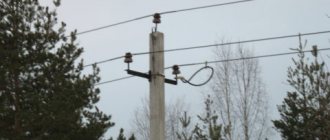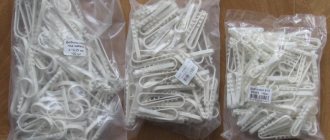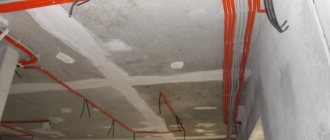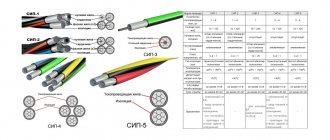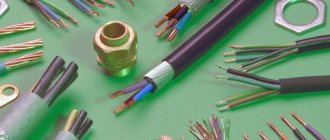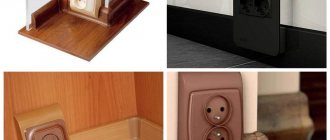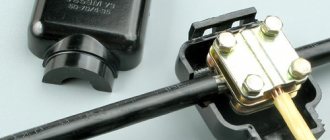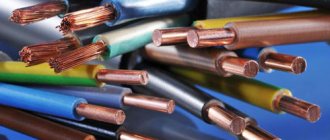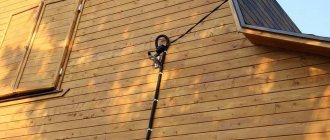With the growing number of energy consumers, SIP wires are effectively replacing conventional bare wires due to their practicality, reliability and safety. Self-supporting wire is widely used in the construction of new power lines, and SIP of four different modifications is also very popular in everyday life. Laying an electrical network using a self-supporting wire allows you to reduce the time it takes to put electrical networks into operation and provide electricity to residential and industrial facilities as quickly as possible. But to carry out installation work yourself, you need to know how to fasten SIPs. Methods for attaching SIP to a pole, types of fasteners, types of self-supporting cables, installation rules, recommendations from specialists when working with SIP will be discussed below.
Description and types of SIP
A self-supporting electrical wire consists of several wires isolated from each other (aluminum wire intertwined). When laying new lines in accordance with GOST R 52373-2005, it is necessary to use a self-supporting cable. According to the new PUE rules, these cables are recommended to be used to connect electricity consumers.
Today there are the following types of SIP:
- SIP-1. This is a four-core cable used in three-phase electrical networks with voltages up to 1000 V. Moreover, three of its cores are designed for connecting phases (isolated from each other), and the fourth (zero) is without braid and has a steel core. They also produce SIP-1A cable, in which the neutral core is insulated.
- SIP-2. All cores in this cable are insulated. Its scope of application is the same as that of the cable described above.
- SIP-3. This is a single-core wire with polyethylene insulation. Thanks to the steel core, it is highly durable. It is used in electrical networks up to 35 kV.
- SIP-4. This is a four-core cable with polyethylene insulation, designed for power lines up to 1000 V. It does not have a steel core. It is often used to make branches from the main power line in country houses and in the private sector.
- SIP-5. It includes two or more insulated conductors, all of them without a steel core. This cable is used in electrical networks up to 1000 V.
Classification and varieties, characteristics
To attach SIP cables, many types of fittings are used.
Below are only the most common of them, in particular those used when setting up the input of electricity to a private home.
- Anchor bracket. Through it, the anchor clamps of the main SIP lines are fastened. It is made of fused aluminum, has good resistance to cold atmosphere and is resistant to corrosion. To attach it, use a stainless steel bandage tape.
- Branch clamp. Necessary to ensure reliable contact with the tinned copper contact plate design even when the wires have a small cross-section. Specifically, it is used to connect cores with a cross-section from 6 to 150 square millimeters with cores with a cross-section from 1.5 to 6 square millimeters. When organizing street lighting and introducing electricity into the premises.
Comparative characteristics of branch clamps (together with a number of interconnected objects).
| Name | Usage | Type | Other characteristics | Compatibility |
| ES-1500 | A support kit is needed to secure the VLI core to the main line supports. Made from durable aluminum | ES-1500 | Core cross-section in sq. mm – 16-95 Weight – 0.31 kg. | With SIP-1, SIP-2 and SIP-4 |
| Die supporting clamp ZP-8-1 | Hanging Type 8 optical cable on overhead power line supports | ZP-8-1 | Weight – 0.06 kg. | With SIP-3 |
| P4X-150 piercing branch clamp | Connecting or branching SIP lines with voltage up to 1 kV | P4X-150 | The cross-section of the subscriber line core is 22 millimeters The cross-section of the residential main line is 35-150 sq. millimeters. Impact resistant plastic. | With SIP-1, SIP-2 and SIP-4 |
| ST 25-150R, piercing branch clamp | See above | ST 25-150R | The cross-section of the subscriber line core is 25-150 millimeters. The cross-section of the main line core is 25-150 square millimeters. Impact resistant plastic. | See above |
| ST-70 R, branch piercing clamp | See above | ST-70 R | The cross-section of the subscriber line core is 4-35 millimeters. Main line – 16-150 sq. millimeters. Impact resistant plastic. | See above |
| ST-25 A, branch piercing clamp | See above | ST-25 A | The cross-section of the subscriber line core is 16-95 millimeters. Main line – 1.5-10 sq. millimeters. Impact resistant plastic. | See above |
| ZOP 120-10, branch piercing clamp | Connecting or branching SIP lines with voltage up to 10 kV | PDO 120-10 | The cross-section of the subscriber line core is 50-150 millimeters. Main line – 50-185 sq. millimeters. Impact resistant plastic. | See above |
| Locks (yoke) B-20 | Fasteners B-20, used for tightening steel tape when installing fiber-optic lines and SIP fittings in overhead lines | B-20 | Size 20 millimeters. Weight – one and a half kilograms. One package – 100 pcs. | With any SIP |
- Anchor clamp. Through it, insulated conductors are secured to branches to inputs up to 1000 watts. The housing here has internal wedges made of thermoplastic, ensuring high reliability of connection with the wire cores and at the same time maintaining its insulation. Made from climate-resistant plastic. The loop used has great strength and is made of hot galvanized steel.
- ·Intermediate clamp. Fittings that attach the SIP-4 system with 2 or 4 load-bearing conductors to corner or intermediate supports. Additional wires are placed along the clamp. The body is made of material that effectively resists ultraviolet radiation.
Comparative characteristics of common models of intermediate clamps.
| Position | Distance from D (wall) to wire (mm) | Diameter of wire harness or cable (mm) | SIP section | Weight, g | How much in a package |
| SF 20 | 20 | 18-55 | 2*16-3*150+95 | 57 | 100 |
| SF 50 | 60 | 18-55 | 2*16-3*150+95 | 64 | 100 |
| SFW 50 | 60 | 18-55 | 2*16-3*150+95 | 57 | 100 |
- Hook. Needed to secure the wire in a suspended state. Material: galvanized steel, installation is performed using two steel strips. Hooks secure cables with conductors to the surfaces of structures and to any other supports.
- Caps. When various SIP systems are laid, bare ends of wires or cores are sure to remain. Sealed end caps are used for insulation. There are several types. Products of the KP series are needed for fixing insulators and hooks, and they themselves are fastened with a threaded connection. End sealed caps of the KI series are needed to be able to restore the removed insulating materials from exposed SIP electrical wires. They also perform the function of protection from negative atmospheric phenomena. Made from polymers that are resistant to such phenomena. Underwater can withstand 6KV voltage.
A small table of common cap models.
| Model | Peculiarities |
| SEST 6-35, 16-150 | Made from elastomer. Needed to cover the exposed ends of the wires. |
| CE 6-35, CE 25-15 | Made from elastic rubber. The ends of the insulated wires are insulated and sealed. |
| White caps SKB-30-3 | Made from elastic rubber. They resist negative atmospheric effects well. Needed to create decorative effects at the junction of the cables with the ceiling. |
Important! All necessary fittings used when installing SIP must be listed in advance in the information on the design of the structure.
Advantages and disadvantages of using SIP
These wires allow:
- ensure the required electrical safety class;
- increase network reliability during operation;
- reduce the cost of maintaining the electrical network (up to 80%);
- reduce installation time and reduce labor costs;
- place electrical lines on the walls of buildings;
- reduce losses during electricity transmission (due to low resistance);
- connect objects without disconnecting the main supply line;
- lay and connect lines on your own.
Disadvantages of SIP:
- cost 20-25% more than conventional wires without insulation;
- many energy suppliers are not ready to use SIP (outdated equipment and no tools for installation);
- Only overhead power lines can be laid.
Types of fasteners for SIP
To lay a self-supporting wire, use the following fasteners:
- intermediate support clamps;
- brackets for fastening anchor clamps;
- brackets for fastening intermediate clamps;
- anchor brackets for power consumer wires;
- anchor clamps for insulated load-bearing neutral core;
- anchor clamps for power consumer wires;
- mounting hooks;
- fastening tape (the tape must be made of stainless steel);
- stainless steel clamps;
- stainless steel yokes;
- fastening ties;
- facade fastenings for SIP;
- Spiral knits.
Clamps
Many clamps allow you to attach two self-supporting cables at once. To do this you need to use another clamp. In this case, fastening the SIP will save not only materials, but also free space. Do not use simple cable ties for this purpose. You only need to install clamps for the self-supporting wire - they are wide. In addition, they are made of high-strength plastic, so they are more durable.
Anchor clamps
Using these clamps, SIPs with an insulated load-bearing neutral core are secured. The anchor clamp consists of a body and self-adjusting wedges that allow you to carefully clamp the neutral core.
Thanks to the flexible cable, you can install up to three clamps on one bracket.
Facade and pillar brackets
The brackets securely hold the anchor clamps on the facade. They differ in design. When choosing these fasteners, you need to consider the purpose for which the cable is used, because power wires often get very hot (heating of the cores up to 90°C is allowed). Such fittings for fastening SIPs must provide a large gap between the walls and the cable so that it is well cooled.
For installation with tape, use brackets with large limiting projections. During the operation of power lines, a backlash appears in them, which is associated with the stretching of the tape. If these SIP fastening units are on supports with small protrusions, then it can jump off the fastening point.
A drawing of an anchor fastening of a self-supporting cable to a reinforced concrete support is shown below.
Anchor brackets and hooks for installation of SIPs
To ensure any economic activity of industrial enterprises, for the normal operation of office and administrative buildings, it is necessary to lay a lot of communications. Among the most important are electricity and communication lines.
A common practice is to lay SIP over long distances to connect remote enterprises, houses and entire settlements. In order to ensure stable operation of all communications, overhead cable lines must be properly secured. It is important to secure the wires on supports, poles and buildings in such a way as to eliminate the possibility of cable breakage, as well as reduce the likelihood of them sagging and breaking. For this purpose, a large number of different kinds of devices are used. Very often, anchor brackets are used for installing SIPs, and also, as an addition, anchor hooks for installing SIPs.
Features of fastening devices for installation of SIP.
Anchor brackets for installation of SIP (Fig. 1) are manufactured in the form of a monoblock using aluminum alloys, which provide them with greater mechanical strength. Such products are intended primarily for installation of anchor clamps on transmission lines. In order to carry out the correct installation of self-supporting insulated wires, various anchor clamps are used, which are installed at the beginning and end of the lines, places of possible sagging, branching of cables and height differences. In order for these clamps to be firmly fixed to transmission line supports and poles, anchor brackets are used for installing SIPs.
Since these products have to be in the open air, under the influence of temperature changes, humidity, gusts of wind and other unfavorable factors, their design involves the use of materials that are resistant to corrosion and can withstand prolonged mechanical loads for a long time. The anchor brackets are attached using various bolts and durable metal tape.
Types of brackets and mounting hooks
When installing SIPs, several of the most common types of fastenings are used:
- The anchor bracket CS 10.3 allows you to attach 1 or 2 anchor clamps to main self-supporting insulated insulated wires. It is produced in the form of a monoblock using aluminum alloys characterized by high mechanical strength. The CS anchor bracket is corrosion resistant and is secured with 14 or 16 mm bolts or F207 metal tape.
- The anchor bracket CA 1500 is used for attaching support clamps. The body is made of an aluminum-zinc alloy and is highly durable and resistant to mechanical damage. The anchor bracket CA 1500 is equipped with a locking ring, which prevents the clamp from turning. The product is fastened using 14-16 mm bolts or metal tape F207. Thanks to its design, the bracket can be easily attached and moved on the support. An RT1 or RT2 roller, used for rolling out SIPs, can be installed in a special hole.
- Anchor hooks for SIP installation (Fig. 2) are used to attach both anchor and support clamps. They can be installed on wood, metal or reinforced concrete transmission line supports. Installation is carried out using metal tapes F207 or F107 in one turn. Anchor hooks for installation of SIPs are made of an alloy of aluminum and zinc, which gives greater strength to the finished product.
Tools and accessories for working with SIP
The following allow you to install a self-supporting wire efficiently and safely:
- tools for tensioning steel mounting tape;
- cable cutting scissors;
- scissors for cutting steel tape;
- winches;
- mounting stockings;
- mounting clamp;
- mounting rollers;
- swivels;
- hydraulic presses for crimping insulated sleeves and tips with cord brush;
- dynamometers;
- cord brushes;
- tools for installing reinforced ties;
- insulated spanners;
- grounding kits;
- separating wedges;
- short-circuit devices;
- universal claws and manholes;
- safety belts;
- slings;
- device for twisting wires.
